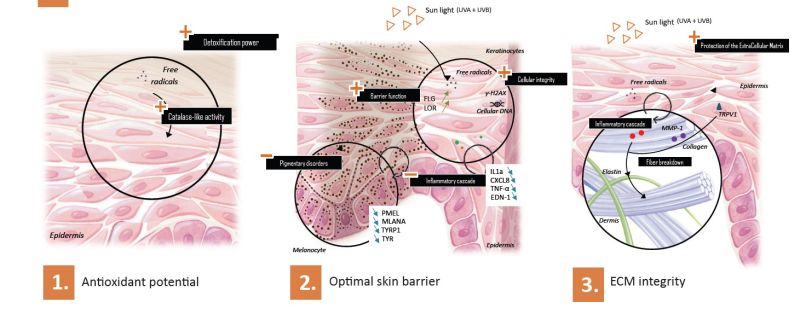Enhanced TDS
Knowde-enriched technical product data sheet
Identification & Functionality
- INCI Name
- Cosmetic Ingredients Functions
- Technologies
- Product Families
Features & Benefits
- Benefit Claims
- Labeling Claims
- Blue Technology Extract from Microalgae
- Photoprotects the skin
- Provides an optimal skin barrier function
- Maintains the 3D skin architecture
- Product Highlights
- Exposure to the sun is the primary harmful factor of the exposome and the main contributor to premature skin aging. UVA, which represents 95% of the UV reaching the skin, and UVB cause deleterious consequences on the epidermis and dermis, leading to premature signs of aging such as wrinkles, solar lentigo, and sagging skin, known as photoaging.
- Intense, chronic, and prolonged sun exposure generates oxidation and inflammation phenomena that initiate a chain reaction in all skin layers. In the epidermis, the first line of defense against UVA and UVB, the UV rays cause DNA damage and inflammation, affecting essential cellular functions and leading to premature aging. UV are thus known to directly affect the skin barrier function and cause, as long term effect, pigmentation disorders.
- In the dermis, UVA primarily alters the extracellular matrix, causing damage to cellular components, disrupting cell functioning, and contributing to progressive loss of elasticity and suppleness.
- The main concern is to protect the skin from the exposome, especially UV rays, to improve skin health and beauty. Ensuring the integrity of the skin layers is key to preventing photoaging.
- Phaeodactylum tricornutum, A Natural Source of Fucoxanthin
Phaeodactylum tricornutum is a microalgae belonging to the largest group of phytoplankton called diatoms. It is found in oceans and seas around the world and is recognized as a key organism in controlling marine resources and predicting climate change. Phaeodactylum tricornutum produces an orange-brown pigment called fucoxanthin, belonging to the family of carotenoids. Although also found in certain brown algae, fucoxanthin is nearly 100 times more concentrated in the microalgae. This essential molecule has two major functions: photosynthesis and protection against oxidative stress. Fucoxanthin works with chlorophyll as a complex capable of widening the spectrum of light absorption, thus maximizing photosynthesis and ensuring optimal growth. Its unique chemical structure gives it exceptional antioxidant power, trapping ROS and protecting the diatom's cellular components against oxidative stress.
- Bio-Inspired Photobioprotection
P. tricornutum and skin shared similarities: both need UV to ensure vital functions but also are vulnerable to oxidative stress. Fucoxanthin absorbs photons in a wide blue-green spectral range. It is also able to scavenge free radicals and reduce oxidative stress. At the skin level, fucoxanthin can help protect from UVinduced damage leading to skin aging. Researchers from Solabia Group have been bio-inspired by these properties to create HelioPure® Skin that protects the skin against UV damage and face photoaging.
Applications & Uses
- Markets
- Applications
- Application Format
- Skin Care Applications
- Sun Care Applications
- Use Level
- 0.005
Properties
- Physical Form
- Soluble in
- Vegetable oil, Octyldodecanol, Caprylic/capric triglyceride
- Typical Properties
Value Units Test Method / Conditions pH Stability 5.5 - 7.5 - -
Regulatory & Compliance
- Certifications & Compliance
- Chemical Inventories
Technical Details & Test Data
- Mode of Action
Bio-inspired, HelioPure® Skin protects the skin from photoaging, extrinsic aging caused by sun exposure:
- it photoprotects the skin from UV rays' damage thanks to its catalase-like activity through its powerful detoxification potential to ensure cell essential functions
- it provides an optimal skin barrier function, helping to strengthen the stratum corneum and modulate the crosstalks between 3 cellular types (keratinocytes, melanocytes, fibroblasts) to prevent pigmentation disorders linked to UV-induced inflammation
- it maintains the 3D skin architecture thanks to the preservation of the ECM fibers integrity
